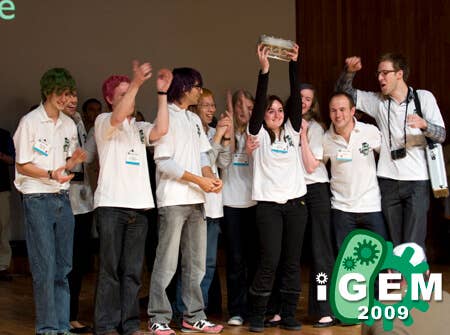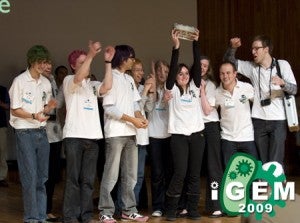4 Great Teams From iGEM 2009 (Videos)

Share

iGEM harnesses two of the most potentially powerful resources on our planet: synthetic biology and youth. The International Genetically Engineered Machine competition took place during the Halloween weekend this year, as always hosted by MIT. College aged (and sometimes younger) students from around the world came together to display the genetically manipulated microorganisms they had produced during the year. Using MIT's Registry for Standard Biological Parts, competitors were able to transform bacteria into biological machines that could accomplish amazing tasks. Mac Cowell from DIYBio was in attendance at the jamboree during iGEM and recorded some of his conversations with various teams. Check out those videos after the break.
This year's iGEM winner was Cambridge University who produced the E. Chromi bacteria. These organisms act as biosensors that produce visible pigments in the presence of designated substances. Imagine a world where the bacteria that already cover most surfaces would become red in the presence of a biohazard. You could instantly see if you were in danger. E. Chromi could one day be adapted to such a purpose. To that end, the Cambridge team developed two important ingredients for E. Chromi, a sensitivity tuner and a color generator. The tuner allows bacteria to be triggered into pigment production only when a detected substance passes a certain threshold. The color generator then creates a pigment. The Cambridge team was able to produce 7 different colors, all of which could be easily spotted without the need for fluorescence.

In the following video, Daisy Ginsberg and James King (not actually part of the Cambridge team) give a brief and humorous glimpse into how E. Chromi could be used.
The BCCS Bristol team focused on a more mundane, but very useful task: protein delivery. Bacteria create outer membrane vesicles (OMVs), external packages that can deliver materials to other cells. Such materials could be proteins, DNA, RNA, or other important cellular products. One day, OMVs could provide the means to directly (and perhaps selectively) deliver necessary proteins to cells in your body. This could open up entirely new avenues of medication. Bristol also made improvements in simulation and BioBrick fusion as part of their research.
City College San Francisco was the first junior college team to compete at iGEM and really performed well. Their project aimed to create a solar powered fuel cell by culturing two different types of bacteria. One strand of bacteria would oxidize iron, the other reduce it, and from these chemical reactions would generate an electric current. When fully realized, this method could provide a means of efficiently generating electricity from sunlight using a medium that could be grown by consumers. Imagine having a friend give you a small pill of bacteria that you cultured into a solar panel that covers your entire roof. As part of getting these cultures to work together well, the photoreactive strand has been fitted with a glucose leaking hole so that it can share food with the non photoreactive strand. This glucose hole figures largely in the discussion in the following video:
Be Part of the Future
Sign up to receive top stories about groundbreaking technologies and visionary thinkers from SingularityHub.


The University of Virginia took on poor water quality by developing e. coli that could safely absorb arsenic in drinking supplies. About 137 million people worldwide are affected by some level of poisoning from water borne arsenic. By removing the gene (a technique called 'knocking out') which allows the bacteria to expel arsenic, Virginia assured that the heavy metal would stay in the cell. They also included a sequestering agent in the bacteria so that it could absorb arsenic and still survive. The safe removal of toxins from the environment by bacteria is called bioremediation and could one day be used all over the world.
As I explored some of the great teams from iGEM 2009, I noticed that safety and security is an increasing focus at the competition. Each team was given a safety survey and toxicity/biohazard awareness figured prominently in the discussions for different groups. While there's yet to be a single (reported) hazard created by an iGEM team, MIT is obviously being very cautious and proactive about such potential problems. Hopefully this vigilance will quell some of the critiques of detractors of synthetic biology.
Another interesting development at iGEM was the involvement of Daisy Ginsberg and James King, who for the lack of a better term are sort of art and design explorers. They took an active interest in the Cambridge team's E. Chromi and tried to map out some of the implications of a world where bacteria produce colors that have important and inherent meanings. You can see their musings at the E. Chromi website, and Mac Cowell has an extended video of their explanation of their work:
As always when discussing iGEM, I feel compelled to point out that the majority of the projects at the competition are no where near being brought to market. Many teams aren't even able to culture large quantities of the synthetic organisms they design. Yes, Cambridge was able to demonstrate how the E. Chromi could produce pigments, but there are many engineering hurdles (production, safety, maintenance, tasking) between that demonstration and a fieldable product. Still, these four teams (and the many others you can explore on the iGEM website) have designed some amazing biological machines and I can't wait to see which continue on to help improve our world. Even if none of these organisms make it to market, this year's iGEM didn't just give us cool new bacteria, it also speculated on some of the concerns and possibilities of its own work. That's the sort of forward thinking and holistic approach to engineering that makes iGEM so spectacular.
Thanks to Mac Cowell for his videos, and make sure to check out his Vimeo channel.
[photo credit: iGEM, Cambridge University]
[video credit: Mac Cowell]
Related Articles

Data Centers in Space: Will 2027 Really Be the Year AI Goes to Orbit?

New Gene Drive Stops the Spread of Malaria—Without Killing Any Mosquitoes

These Robots Are the Size of Single Cells and Cost Just a Penny Apiece
What we’re reading